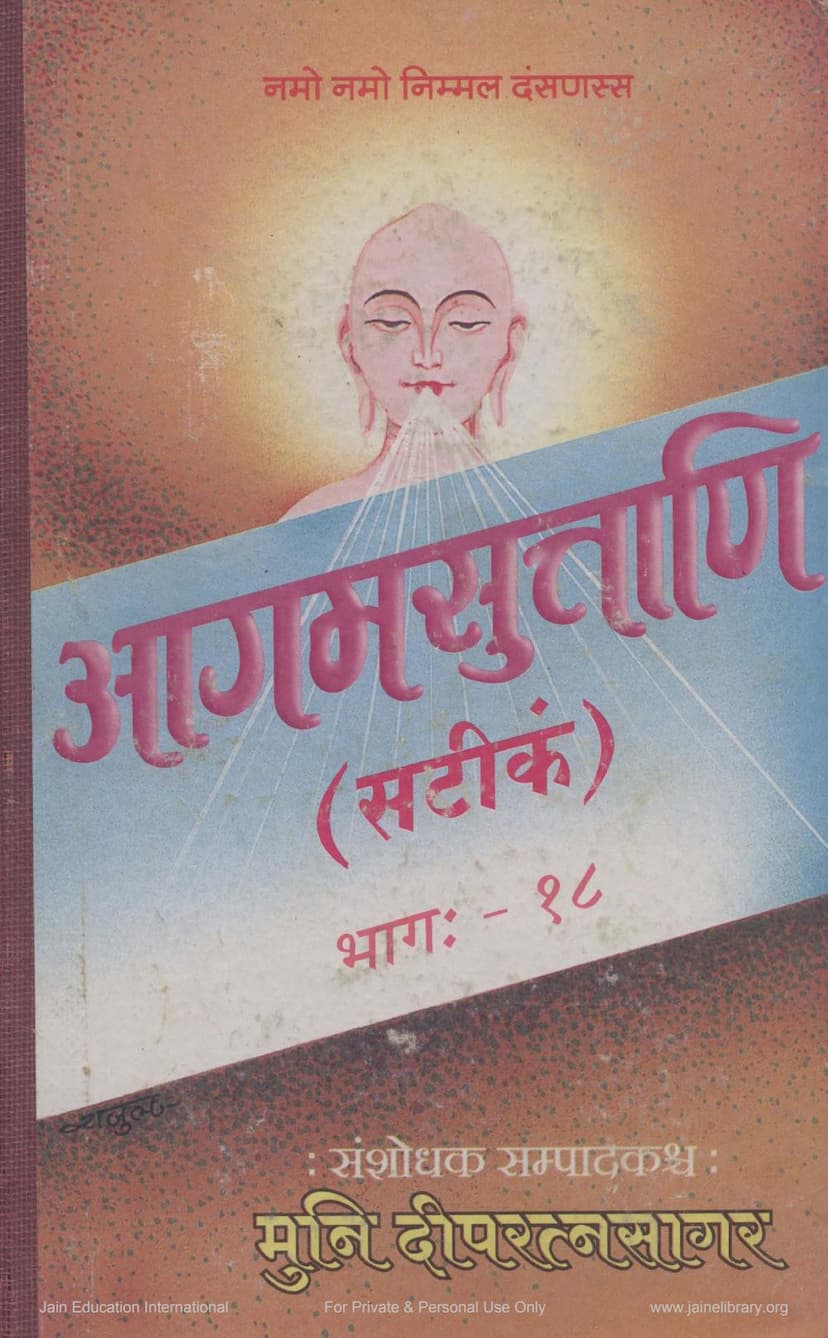Agam Suttani Satikam Part 18 Bruhat Kalpa
Added to library: September 1, 2025

Summary
This document is the 18th part of the "Agam Suttani Satikam" series, titled "Bruhat Kalpa" (Vol 1), authored by Muni Dipratnasagar. It is published by Agam Shrut Prakashan.
The book is a commentary on the Brihat Kalpa Sutra, a significant text in Jainism that deals with monastic conduct and rules.
Here's a breakdown of the content based on the provided pages:
-
Pages 1-2: These pages contain introductory material, including the title, author, publisher, a salutation ("Namo Namo Nirmal Dassanass"), and a dedication to spiritual gurus. It also specifies that this volume covers the "Brihat Kalpa Chhed Sutra, Part 1," focusing on the "Pithika" (introduction) and "Uddeshak-1" (chapter 1) covering foundational verses (Mool 1-7).
-
Page 3: This page provides a detailed table of contents (Vishayanukram) for the "Pithika" and "Uddeshak-1." It lists various topics covered, including:
- Mangala (auspicious invocation)
- Nandi (five types of knowledge)
- Samyaktva (right faith)
- Samyak Shruta (right scripture)
- Various types of doors (Nikshepa Dwar, Ekaritik Dwar, Nirukta Dwar, etc.)
- Detailed explanations of concepts related to monastic practice (Mula, Artha, Tadubhay, Upasthapana, Vichar, Sthandalbhumi, Shuddhi, Apaya, Varjana, Anugna, Lepa, Pind, Shayya, Vastra, etc.)
- Specific verses related to prohibitions and permissions (Prilamba Sutra, Anantkaya Varjan Dwar, etc.)
- Descriptions of the Jinakalpika (monks who follow the strict path of Mahavira) and Gachchhavasi (monks belonging to a specific monastic lineage).
-
Pages 4-16: These pages are primarily devoted to the Pithika (Introduction) and the first chapter (Uddeshak-1) of the Brihat Kalpa Sutra. The content includes:
- Mangala: The text begins with a detailed explanation of the importance of auspicious invocations (Mangala) at the beginning, middle, and end of a scripture. It quotes a verse stating the purpose of Mangala for the auspiciousness and continuation of scriptures across generations.
- Authorship and Lineage: It clarifies the origin of the scriptures, mentioning that the Kalpa Sutra and Vyavahara Sutra were composed by Bhagavan Bhadrabahu Swami due to the difficulty of accessing the original texts in the declining era (Dashamaan era). It further states that the Bhashya (commentary) was written by Sanghadassagani, and the Vritti (further commentary) by Acharya Malayagiri and Acharya Khemkirti.
- Upo-dhat (Introduction to the Scripture): The text emphasizes the importance of the Upo-dhat, comparing it to a lamp illuminating a dark room, without which the scripture, though profound, might not be fully appreciated.
- Detailed Explanation of Kalpa and Vyavahara: The text delves into the meaning of "Kalpa" and "Vyavahara," exploring their multiple meanings and applications in Jain philosophy.
- Nandi and Mangala: It explains the concept of Nandi, which serves as a auspicious beginning, and its relationship with Mangala. The text details the classification of knowledge (Jnana) into various categories (perceptible/aparoksha, imperceptible/aparoksha, etc.) and further breaks down Shruta Jnana (scriptural knowledge) into its various types (Akshara, Samjnin, Samyak, etc.).
- Types of Mangala: It discusses the four types of Mangala: Nama (name), Sthapana (symbolic representation), Dravya (material object), and Bhava (mental state).
- Detailed analysis of various 'Dwaras' (Doors/Topics): The text meticulously explains numerous 'Dwaras' (topics or categories of discussion) relevant to Jain philosophy and monastic practice, such as the Nishedha (prohibition), Dravy, Kshettra, Kal, Vachana, and Bhava perspectives.
- Gyan (Knowledge): A significant portion is dedicated to explaining the different types of knowledge (Mati, Shruta, Avadhi, Manahparyaya, Kevala) and their characteristics.
- Conduct and Rules: The text covers various aspects of monastic conduct, including rules about food, clothing, dwelling, and the behaviour of monks and nuns, particularly in different contexts (e.g., during festivals, in different locations).
- Pravritti (Conduct/Behavior): It discusses the principles of conduct and the proper way to perform actions.
- Adhikara (Authority/Relevance): It touches upon the authority of scriptures and the lineage of teachers.
Overall, this part of the Brihat Kalpa Sutra, as presented in this volume, serves as a foundational introduction, setting the stage for a deep dive into the intricate rules and philosophical concepts of Jain monasticism. The detailed table of contents on page 3 indicates a comprehensive approach to explaining the initial sections of this important text.